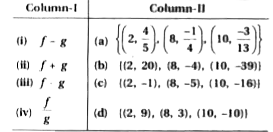Let f={(2,4),(5,6),(8,−1),(10,−3)andg{(2,5)(7,1),(8,4),(10,13),(11,5)} be two real functions. Then, match the following.

The domain of f−g,f+g,f.g,fg is domain of f∩ domain of g. Then, find their images.Solution in Gujrati
The correct Answer is:(i)→(c),(ii)→(d),(iii)→(b),(iv)→(a)
Step by step video, text & image solution for Let f= {(2,4), (5,6), (8, -1), (10, -3) and g{(2, 5) (7, 1), (8, 4), (10, 13), (11,5)} be two real functions. Then, match the following. The domain of f-g, f+ g, f.g, (f)/(g) is domain of f nn domain of g. Then, find their images. by Maths experts to help you in doubts & scoring excellent marks in Class 11 exams.
Topper's Solved these Questions
- BOOK - KUMAR PRAKASHANCHAPTER - RELATIONS AND FUNCTIONSEXERCISE - Solutions of NCERT Exemplar Problems (True/False)5videos
RELATIONS AND FUNCTIONS
- BOOK - KUMAR PRAKASHANCHAPTER - RELATIONS AND FUNCTIONSEXERCISE - Solutions of NCERT Exemplar Problems (Question of Module)16videos
RELATIONS AND FUNCTIONS
- BOOK - KUMAR PRAKASHANCHAPTER - RELATIONS AND FUNCTIONSEXERCISE - Solutions of NCERT Exemplar Problems (Objective Type Questions)12videos
RELATIONS AND FUNCTIONS
- BOOK - KUMAR PRAKASHANCHAPTER - PROBABILITYEXERCISE - PRACTICE WORK40videos
PROBABILITY
- BOOK - KUMAR PRAKASHANCHAPTER - SEQUENCE AND SERIESEXERCISE - Solutions of NCERT Exemplar Problems -Question of Module19videos
SEQUENCE AND SERIES
Similar Questions
The ordered pair (5,2) belongs to the relation R={(x,y):y=x−5,x,y∈Z}
02:37View SolutionA={−1,0},B={−1,0,1}, then find A×BandB×A
03:34View Solutionn(A)= m, n (B) = n. The total number of non empty relation from A to B is……..
04:44View SolutionTwo coins (a one rupee coin and a two rupee coin) are tossed once. Find a sample space.
02:18View SolutionThe terms 1,1,2,3,5,8,13,……respresents which sequence?
07:00View SolutionA function f has domain [−1,2] and rang [0,1] . Find the domain and range of the function g defined by g(x)=1−f(x+1).
02:05View SolutionIf f and g are two continuous functions on their common domain D then f+g and f−g is continuous on D.
02:57View SolutionIf f and g are two continuous functions on their common domain D then f.g and fg is continuous on D provided g(x) is defined at that point.
03:05View SolutionLet f and g be two real functions given by
f={(0,1),(2,0),(3,−4),(4,2),(5,−1)}
and g={(1,0),(2,2),(3,−1),(4,4),(5,3)}
then the domain of f⋅g is given by ..........03:27View SolutionLet f={(2,4),(5,6),(8,−1),(10,3)
and g={(2,5),(7,1),(8,4),(10,13),(11,5)}
be two real functions. Then, match the following .

The domain of f−g,f+g,f⋅g,fg is domain of f ∩ domain of g. Then, find their images.02:53View SolutionLet f(x) be a function whose domain is [−5,6]. Let g(x)=|2x+5|,then domain of (fog)(x) is
01:42View SolutionIf two real functions f and g are defined respectively by f(x)=√x+1andg(x)=√x−1, then the find the values of fg(1)andgf(1). Also find the domain of definitions of fgandgf.
05:58View SolutionLet f and g be two real functions given by
f={(0,1),(2,0),(3,−4),(4,2),(5,−1)}
and g={(1,0),(2,2),(3,−1),(4,4),(5,3)}
then the domain of f⋅g is given by ..........01:45View SolutionA function f has domain [−1,2] and range [0,1] . Find the domain and range of the function g defined by g(x)=1−f(x+1).
05:57View SolutionLet f a n d g be two functions given by f={(2,4), (5,6), (8,-1), (10 ,-3)} a n d g={(2,5), (7,1),(8,4),(10 , 13),(11,-5)}. Find the Domain of f + g
01:53View Solution

